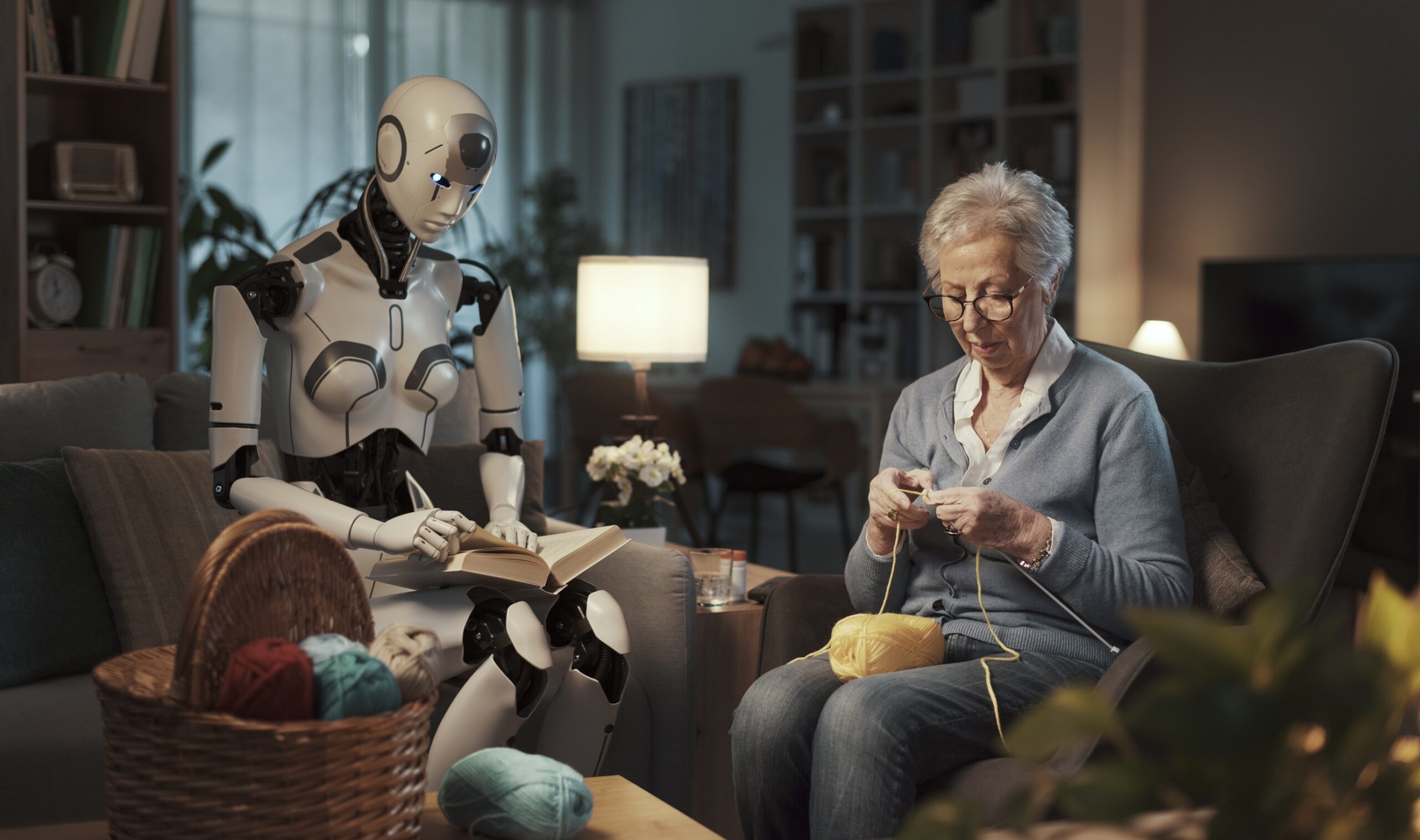Isn’t it ironic how yesterday’s science fiction becomes today’s “science fact”? Technology we once dismissed as too outlandish to be real is now commonplace, from personal computers to the smartphone to driverless cars to artificial intelligence. The lesson seems to be, don’t be too hasty in dismissing notions that might seem far-fetched.
Enter the robot caregiver.
In the face of an aging population and a shrinking workforce of human caregivers, it’s only a matter of time before this idea catches on. That was our take-away as we read this report from the BBC that we came across a few weeks ago. In the article, BBC science correspondent Pallab Ghosh takes a look at some of the latest robotic developments from the UK and Japan.
The conclusion: while the industry is in its infancy when it comes to robots actually providing care, the likelihood is strong that high tech caregivers – in one form or another – will become part of the landscape in the not-too-distant future. So, with that in mind, let’s take a look at the current state of the art in robotic caregiving. (As we do, please note that we’ve edited material from the BBC article due to limited space. We encourage you to read the original online for more detail.)
Goal is to Provide Help, Not to Build “Terminator”
Ghosh begins his article with this evocative image: “Hidden away in a lab in northwest London three black metal robotic hands move eerily on an engineering work bench. No claws, or pincers, but four fingers and a thumb opening and closing slowly, with joints in all the right places.”
An intimidating vision, maybe, but the director of robotics firm Shadow Robot, Rich Walker, is quick to quip, “We’re not trying to build Terminator.”
He adds, “We set out to build the robot that helps you, that makes your life better, your general-purpose servant that can do anything around the home, do all the housework…”
Deeper Ambition is to Help Address the Caregiving Crisis
But, Ghosh tells us, the real goal here is clear: to address a serious crisis in the UK and beyond, which is the escalating shortage of caregivers.
“There were 131,000 vacancies for adult care workers in England, a report by the charity Skills for Care found last year,” Ghosh writes. “And in all, around two million people aged 65 and over in England are living with unmet care needs, according to Age UK. By 2050, one in four people in the UK is expected to be aged 65 or over, potentially putting more strain still on the care system.”
This, he says, is where robots come in.
UK Government Invests Millions in Robot Caregiving
This isn’t a niche interest, either. The previous government in the UK invested heavily in caregiving robotics, to the tune of £34 million (over $56 million), explaining in 2019 that, “within the next 20 years, autonomous systems like… robots will become a normal part of our lives, transforming the way we live, work and travel.”
But Ghosh poses the question that many of us may also share: is this really the solution? “And,” he writes, “would you really trust your elderly relatives, or yourself when you’re at your most vulnerable with what is essentially a very strong machine?”
Japanese Care Facilities are Testing Multiple Robot Models
For a cultural example of how humans and robots could co-exist, Ghosh turns our attention to Japan. “Ten years ago, [Japan’s] government began offering subsidies to robot manufacturers to develop and popularize the use of robots in care homes – fueled in part by an aging population and relative lack of care home staff,” he explains.
Dr. James Wright, an AI specialist and visiting professor at Queen Mary University of London, spent seven months observing three types of robots and how well they worked in a Japanese care home. The three types of robots studied were called HUG, Paro, and Pepper.
HUG, Paro, and Pepper: Different Designs, Distinct Functions
HUG, designed by Fuji Corporation in Japan, looks like a sophisticated walking frame. Ghosh writes, “It had support pads that people could lean right into, and it helped carers lift people from bed to, say, a wheelchair or the toilet.”
Paro looked “a bit like a baby seal” and was intended to stimulate dementia patients, trained to respond to touch, movement, and sound.
And finally, Pepper was a humanoid robot with a friendly appearance. “It could give instructions and also demonstrate exercises by moving its arms – and was used to lead exercise classes in the care home,” Ghosh writes.
Hype Meets Reality as Staff Works with Robotic Caregivers
Before observing the robots in action, Dr. Wright confessed that he had “bought into the hype” a bit: “I was expecting that the robots would be easily adopted by care workers who were massively overstretched and extremely busy in their work,” he says. “What I found was almost the opposite.”
Instead, he found that the time it took the care home staff to clean, recharge, and maintain the robots was the single biggest drain on their time. “After several weeks the care workers decided the robots were more trouble than they were worth and used them less and less, because they were too busy to use them,” he told Ghosh.
He continued, “HUG had to be moved around all the time to get [it] out of the residents’ way. Paro caused distress to one of the residents who had become overly attached to it. And they couldn’t follow Pepper’s exercise routines because it was too short for people to see – and they couldn’t hear it properly because its voice was too high-pitched.”
Developers Go Back to the Drawing Board
The developers of the care robots did respond to Dr. Wright’s observations, and made some changes according to his research. “The developers behind HUG says that since then they’ve refined the design to make it more compact and user-friendly,” Ghosh writes. “Paro’s creator Takanori Shibata said that Paro has been used for 20 years and pointed to trials that demonstrated ‘clinical evidence of [the] therapeutic effects.’”
As for Pepper? It’s now owned by a different company, and its software has been “substantially updated”. But Dr. Wright’s observations still remain relevant, and today’s designers of caregiving robots are determined to improve on the formula.
In the Real World, Users Have Different Desires, Prorities
One such designer is Praminda Caleb-Solly, professor at University of Nottingham, who hopes to make caregiving robots practical. Her network, Emergence, helps connect robot makers with businesses and the people who will use them.
“We are trying to get these robots out of the labs into the real world,” she says.
Her network has also asked elderly people directly: what do they want to see in a helper robot? The answers vary. Ghosh writes, “Some people have said they want robots with voice interaction and, understandably, a non-threatening appearance. Others want a ‘cute design’. But many requests come down to the practical way they’d like the robot to adapt to their changing needs – and for the robot to charge and clean itself.”
As one respondent put it: “We don’t want to look after the robot – we want the robot to look after us.”
One UK Company Has Found Mixed Results in Real World Tests
Other businesses are testing robotic services as well, such as home care provider Caremark. They have been trying out a small voice-activated robot called Genie in a limited test.
But while there have been some positive responses to Genie, the reactions have been mixed, overall. Some folks have loved it, and some have been “less complimentary.”
Caremark director Michael Folkes is quick to stress that these robots aren’t meant to replace human interaction. “We’re trying to build a future where carers have more time to care,” he says.
Useful Household Robots Will Require Human-like Hands
Back at Shadow Robot Company, Rich Walker has pinpointed one of the biggest challenges in caregiving robotics: mastering a fully functional robotic hand. “For the robot to be useful, it needs to have the same ability to interact with the world as [a] human does,” he explains. “And for that it needs human-like dexterity.”
The specimen showed to Ghosh was “made from metal and plastic, and fitted with 100 sensors, with the dexterity and strength of a human hand,” he writes. “Each finger moves to touch its thumb smoothly, quickly and precisely, finishing with an ‘OK’ to sign off.
It can even do a Rubik’s Cube, one-handed.”
He adds, “Yet it is still a long way from doing the more delicate tasks, like using a pair of scissors or picking up smaller, more fragile objects.”
This challenge of creating the perfect hand is so crucial to the future of robots that Walker’s team has joined with 26 other engineering firms to create the Robot Dexterity Programme, run by a government agency called the Advanced Research and Invention Agency.
Will Robots Make Caregivers’ Lives Better or Worse?
Dr. Wright—the observer of care home robots in Japan—did share one final concern: that if they catch on, they might make life actively harder for human caregivers.
“The only way that economically you can make this work is to pay the care workers less and have much larger care homes, which are standardized to make it easy for robots to operate in,” he argues. “As a result, there would be more robots taking care of people, with care workers being paid a minimum wage to service the robots, which is the opposite of this vision that robots are going to give time back to care workers to spend quality time with residents, to talk.”
“Like It or Not, the Robots Are Coming”
But while his voice is heard, other experts have a more optimistic view. Gopal Ramchurn, a professor of artificial intelligence at the University of Southampton, says, “It’s going to be a huge industry, given the deficit we have in the workforce right now. The demand for carers as our population ages will be huge.”
This is a key aspect of his research, as he is the CEO of Responsible AI, involved in ensuring that artificial intelligence systems are “safe, reliable, and trustworthy.”
But the robots are coming, Ramchurn says. You need look no further than Elon Musk’s Optimus robot, which served drinks at a Tesla event last year.
“We are trying to anticipate that future, before the big tech companies come in and deploy these things without asking us what we think about them,” he says. And because of this, now is the time to develop the right rules and ethics around robots as tools.
Ramchurn says, “We need to be ready for that future.”
(originally reported at www.bbc.com)


